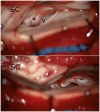The Pathogenesis of Ventral Idiopathic Herniation of the Spinal Cord: A Hypothesis Based on the Review of the Literature
- PMID: 28955299
- PMCID: PMC5601982
- DOI: 10.3389/fneur.2017.00476
The Pathogenesis of Ventral Idiopathic Herniation of the Spinal Cord: A Hypothesis Based on the Review of the Literature
Abstract
Idiopathic ventral herniation of the spinal cord (SC) is not often encountered in daily practice. Its clinical prevalence, however, will increase through increasing awareness and more frequent use of MRI. A clear explanation of its pathophysiology has never been formulated. It was hypothesized that the findings during surgery might indicate the real causative mechanism. An extensive literature search was performed, using Embase, PubMed, and Google Scholar. Titles and abstracts were screened by two investigators, using strict inclusion and exclusion criteria. Reference lists of the full paper versions of each included article were checked. The following data were registered for the articles included: age, gender, level of herniation, relation to intervertebral disk, duration of symptoms, findings from surgery, and outcomes. Nine cases treated at our department were added. A total of 117 articles reporting on 259 patients were included. Including our cases, 268 patients were reviewed. Females outnumbered males (160/100). The mean age was 51.3 ± 12.0 years. In 236 patients, the duration of symptoms was reported: 55.5 ± 55.6 months. In 178 patients, the intraoperative findings for the herniated part of the SC were not mentioned. In 59 patients, a tumor-like extrusion was seen, without any alteration to the SC. Deformation of the SC itself was never observed. Biopsies of these structures were without clinical consequence. Based on the intraoperative findings reported in literature and the cases presented, acquired causes, such as trauma and erosion of the dura due to a herniated disk, were not plausible. We hypothesize that a non-functioning appendix to the SC can only develop during an early embryologic phase, in which several layers separate. We propose renaming this entity as congenital transdural appendix of the SC.
Keywords: congenital; embryology; review; spinal cord herniation; transdural appendix.
Figures






Similar articles
-
Duplication of Ventral Dura as a Cause of Ventral Herniation of Spinal Cord-A Report of Two Cases and Review of the Literature.World Neurosurg. 2019 Jun;126:346-353. doi: 10.1016/j.wneu.2019.02.143. Epub 2019 Mar 6. World Neurosurg. 2019. PMID: 30851464 Review.
-
Idiopathic ventral spinal cord herniation: an increasingly recognized cause of thoracic myelopathy.J Cent Nerv Syst Dis. 2014 Oct 1;6:85-91. doi: 10.4137/JCNSD.S16180. eCollection 2014. J Cent Nerv Syst Dis. 2014. PMID: 25336997 Free PMC article.
-
Idiopathic herniation of the thoracic spinal cord: report of three cases.Spine (Phila Pa 1976). 2001 Oct 15;26(20):E488-91. doi: 10.1097/00007632-200110150-00030. Spine (Phila Pa 1976). 2001. PMID: 11598531
-
Idiopathic spinal cord herniation: a new theory of pathogenesis.Surg Neurol. 2004 Aug;62(2):161-70; discussion 170-1. doi: 10.1016/j.surneu.2003.10.030. Surg Neurol. 2004. PMID: 15261515 Review.
-
Pathogenesis of Idiopathic Ventral Herniation of Spinal Cord: Neuropathologic Analysis.World Neurosurg. 2018 Jun;114:30-33. doi: 10.1016/j.wneu.2018.02.187. Epub 2018 Mar 10. World Neurosurg. 2018. PMID: 29530682 Review.
Cited by
-
Double trouble!!! An unusual presentation of cervical cord herniation and medial end clavicle non-union in a single patient.BMJ Case Rep. 2018 Apr 18;2018:bcr2018224393. doi: 10.1136/bcr-2018-224393. BMJ Case Rep. 2018. PMID: 29669773 Free PMC article.
-
A successful surgical management of spinal cord herniation in a patient with old thoracic spine fracture: a case report from Syria.Int J Surg Case Rep. 2025 Jun;131:111394. doi: 10.1016/j.ijscr.2025.111394. Epub 2025 Apr 29. Int J Surg Case Rep. 2025. PMID: 40306102 Free PMC article.
-
Genetic analysis of spinal dysraphism with a hamartomatous growth (appendix) of the spinal cord: a case series.BMC Neurol. 2020 Apr 6;20(1):121. doi: 10.1186/s12883-020-01710-7. BMC Neurol. 2020. PMID: 32252670 Free PMC article.
-
Remarkable improvement of neurological deficits after surgery in patients with Idiopathic spinal cord herniations. The impact of peroperative neuromonitoring. Case reports.Brain Spine. 2023 Jul 21;3:101785. doi: 10.1016/j.bas.2023.101785. eCollection 2023. Brain Spine. 2023. PMID: 38021003 Free PMC article.
-
Case Report: Idiopathic Spinal Cord Herniation: An Overlooked and Frequently Misdiagnosed Entity.Front Surg. 2022 May 20;9:905038. doi: 10.3389/fsurg.2022.905038. eCollection 2022. Front Surg. 2022. PMID: 35711698 Free PMC article.
References
LinkOut - more resources
Full Text Sources
Other Literature Sources

